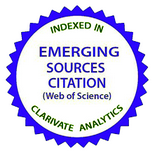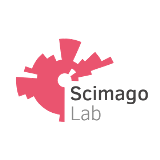Influence of a Capping Ligand on the Band Gap and Excitonic Levels in Colloidal Solutions and Films of ZnSe Quantum Dots
DOI:
https://doi.org/10.15407/ujpe64.5.425Keywords:
quantum dot, exciton, ZnSe, energy transfer, ligandsAbstract
Semiconductor quantum dots are promising nanostructures for their application in solar cells of the 3rd generation, photodetectors, light emitting diodes, and as biological markers. However, the issue concerning the influence of superficial organic stabilizers (ligands) on the energy of excitons in quantum dots still remains open. In this work, by analyzing the optical spectra of colloidal solutions and films of ZnSe quantum dots stabilized with 1-thioglycerol, it is found that the energy of excitons and their migration depend not only on the quantum confinement effect, but also on the superficial contribution from the thiol stabilizer group –
SH. The dependence of the exciton energy in ZnSe quantum dots on the surface stabilizer concentration is experimentally revealed for the first time. The short size of the stabilizer molecular chain and the large initial energy of excitons are shown to result in the effective migration of excitons over an array of quantum dots.
References
R.D. Harris, S.B. Homan, M. Kodaimati, Chen He, A.B. Nepomnyashchii, N.K. Swenson, S. Lian, R. Calzada, E.A. Weiss. Electronic processes within quantum dot-molecule complexes. Chem. Rev. 116, 12685 (2016). https://doi.org/10.1021/acs.chemrev.6b00102
N. Kholmicheva, P. Moroz, H. Eckard, G. Jensen, M. Zamkov. Energy transfer in quantum dot solids. ACS Energy Lett. 2, 154 (2017). https://doi.org/10.1021/acsenergylett.6b00569
N. Hildebrandt, C.M. Spillmann, W.R. Algar, T. Pons, M.H. Stewart, E. Oh, K. Susumu, S.A. D??az, J.B. Delehanty, I.L. Medintz. Energy transfer with semiconductor quantum dot bioconjugates: A versatile platform for biosensing, energy harvesting, and other developing applications. Chem. Rev. 117, 536 (2016). https://doi.org/10.1021/acs.chemrev.6b00030
M.T. Frederick, V.A. Amin, L.C. Cass, E.A. Weiss. A molecule to detect and perturb the confinement of charge carriers in quantum dots. Nano Lett. 11, 5455 (2011). https://doi.org/10.1021/nl203222m
M.T. Frederick, V.A. Amin, N.K. Swenson, A.Y. Ho, E.A. Weiss. Control of exciton confinement in quantum dot-organic complexes through energetic alignment of interfacial orbitals. Nano Lett. 13, 287 (2013). https://doi.org/10.1021/nl304098e
M.S. Kodaimati, Ch. Wang, C. Chapman, G.C. Schatz, E.A. Weiss. The distance-dependence of inter-particle energy transfer in the near-infrared within electrostatic assemblies of PbS quantum dots. ACS Nano 11, 5041 (2017). https://doi.org/10.1021/acsnano.7b01778
M. Sykora, A.Y. Koposov, J.A. McGuire, R.K. Schulze, O. Tretiak, J.M. Pietryga, V.I. Klimov. Effect of air exposure on surface properties, electronic structure, and carrier relaxation in PbSe nanocrystals. ACS Nano 4, 2021 (2012). https://doi.org/10.1021/nn100131w
S. Kundu, A. Patra. Nanoscale strategies for light harvesting. Chem. Rev. 117, 712 (2017). https://doi.org/10.1021/acs.chemrev.6b00036
C.S. Ponseca Jr., P. Chabera, J. Uhlig, P. Persson, V. Sundstr?om. Ultrafast electron dynamics in solar energy conversion. Chem. Rev. 117, 10940 (2017). https://doi.org/10.1021/acs.chemrev.6b00807
R.D. Harris, V.A. Amin, B. Lau, E.A. Weiss. Role of interligand coupling in determining the interfacial electronic structure of colloidal CdS quantum dots. ACS Nano 10, 1395 (2016). https://doi.org/10.1021/acsnano.5b06837
A.Ch.A. Silva, S.W. da Silva, P.C. Morais, N.O. Dantas. Shell thickness modulation in ultrasmall CdSe/CdSxSe1?x/CdS core/shell quantum dots via 1-thioglycerol. ACS Nano 8, 1913 (2014). https://doi.org/10.1021/nn406478f
Y.Q. Zhang, X.A. Cao. Optical characterization of CdSe quantum dots with metal chalcogenide ligands in solutions and solids. Appl. Phys. Lett. 99, 023106 (2011). https://doi.org/10.1063/1.3610456
S.K. Sarkar, G. Hodes. Charge overlap interaction in quantum dot films: Time dependence and suppression by cyanide adsorption. J. Phys. Chem. B. 109, 7214 (2005). https://doi.org/10.1021/jp044465d
Y. Nosaka, K. Yamaguchi, H. Miyama, H. Hayashi. Reversible adsorption-enhanced quantum confinement in semiconductor quantum dots. Appl. Phys. Lett. 81, 5045 (2002). https://doi.org/10.1063/1.1532109
D.I. Kim, M.A. Islam, L. Avila, I.P. Herman. Contribution of the loss of nanocrystal ligands to interdot coupling in films of small CdSe/1-thioglycerol nanocrystals. J. Phys. Chem. B 107, 6318 (2003). https://doi.org/10.1021/jp030168h
N.V. Bondar, M.S. Brodin, N.A. Matveevskaya. Influence of surface and polarization effects on electronic excitation energy transfer in colloidal solutions and films of ZnSe quantum dots. Low Temp. Phys. 44, 1532 (2018). https://doi.org/10.1063/1.5062158
B. Goswami, S. Pal, P. Sarkar. Theoretical studies of the effect of surface passivation on structural, electronic, and optical properties of zinc selenide clusters Phys. Rev. B 76, 045323 (2007). https://doi.org/10.1103/PhysRevB.76.045323
Y. Nosaka. Finite depth spherical well model for excited states of ultrasmall semiconductor particles. An applicat-lon. J. Phys. Chem. 95, 5054 (1991). https://doi.org/10.1021/j100166a028
G.B. Grigoryan, A.V. Rodina, A.L. Efros. Confined excitons and biexcitons in semiconductor microcrystals embedded in an insulating glass matrix. Fiz. Tverd. Tela 32, 3512 (1990).
P. Schapotschnikow, B. Hommersom, T.J.H. Vlugt. Adsorption and binding of ligands to CdSe nanocrystals. J. Phys. Chem. C. 113, 12690 (2009). https://doi.org/10.1021/jp903291d
Boon-Kin Pong, B.L. Trout, Jim-Yang Lee. Modified ligand-exchange for efficient solubilization of CdSe/ZnS quantum dots in water: A procedure guided by computational studies. Langmuir 24, 5270 (2008). https://doi.org/10.1021/la703431j
S. Baskoutas, A.F. Terzis. Size-dependent band gap of colloidal quantum dots. J. Appl. Phys. 99, 013708 (2006). https://doi.org/10.1063/1.2158502
J. Eilers, J. van Hest, A. Meijerink, C. de Mello Donega. Unravelling the size and temperature dependence of exciton lifetimes in colloidal ZnSe quantum dots. J. Phys. Chem. C. 118, 23313 (2014). https://doi.org/10.1021/jp5038238
V.A. Amin, K.O. Aruda, B. Lau, A.M. Rasmussen, K. Edme, E.A.Weiss. Dependence of the band gap of CdSe quantum dots on the surface coverage and binding mode of an exciton-delocalizing ligand, methylthiophenolate. J. Phys. Chem. C. 119, 19423 (2005). https://doi.org/10.1021/acs.jpcc.5b04306
N.V. Bondar, M.S. Brodin, A.M. Brodin, N.A. Matveevskaya. Photoluminescence and confinement of excitons in disordered porous films. Semiconductors 50, 346 (2016). https://doi.org/10.1134/S1063782616030039
N.V. Bondar, M.S. Brodin. Free and bound states of excitons in a percolation cluster of ZnSe quantum dots in a dielectric matrix. Low Temp. Phys. 37, 1026 (2011). https://doi.org/10.1063/1.3674196
N.V. Bondar, M.S. Brodyn, N.A. Matveevskaya, T.G. Beynik. Electronic excitation energy transfer in an array of CdS quantum dots on a quasi-two-dimensional surface. Semiconductors 53, 188 (2019). https://doi.org/10.1134/S1063782619020040
Downloads
Published
How to Cite
Issue
Section
License
Copyright Agreement
License to Publish the Paper
Kyiv, Ukraine
The corresponding author and the co-authors (hereon referred to as the Author(s)) of the paper being submitted to the Ukrainian Journal of Physics (hereon referred to as the Paper) from one side and the Bogolyubov Institute for Theoretical Physics, National Academy of Sciences of Ukraine, represented by its Director (hereon referred to as the Publisher) from the other side have come to the following Agreement:
1. Subject of the Agreement.
The Author(s) grant(s) the Publisher the free non-exclusive right to use the Paper (of scientific, technical, or any other content) according to the terms and conditions defined by this Agreement.
2. The ways of using the Paper.
2.1. The Author(s) grant(s) the Publisher the right to use the Paper as follows.
2.1.1. To publish the Paper in the Ukrainian Journal of Physics (hereon referred to as the Journal) in original language and translated into English (the copy of the Paper approved by the Author(s) and the Publisher and accepted for publication is a constitutive part of this License Agreement).
2.1.2. To edit, adapt, and correct the Paper by approval of the Author(s).
2.1.3. To translate the Paper in the case when the Paper is written in a language different from that adopted in the Journal.
2.2. If the Author(s) has(ve) an intent to use the Paper in any other way, e.g., to publish the translated version of the Paper (except for the case defined by Section 2.1.3 of this Agreement), to post the full Paper or any its part on the web, to publish the Paper in any other editions, to include the Paper or any its part in other collections, anthologies, encyclopaedias, etc., the Author(s) should get a written permission from the Publisher.
3. License territory.
The Author(s) grant(s) the Publisher the right to use the Paper as regulated by sections 2.1.1–2.1.3 of this Agreement on the territory of Ukraine and to distribute the Paper as indispensable part of the Journal on the territory of Ukraine and other countries by means of subscription, sales, and free transfer to a third party.
4. Duration.
4.1. This Agreement is valid starting from the date of signature and acts for the entire period of the existence of the Journal.
5. Loyalty.
5.1. The Author(s) warrant(s) the Publisher that:
– he/she is the true author (co-author) of the Paper;
– copyright on the Paper was not transferred to any other party;
– the Paper has never been published before and will not be published in any other media before it is published by the Publisher (see also section 2.2);
– the Author(s) do(es) not violate any intellectual property right of other parties. If the Paper includes some materials of other parties, except for citations whose length is regulated by the scientific, informational, or critical character of the Paper, the use of such materials is in compliance with the regulations of the international law and the law of Ukraine.
6. Requisites and signatures of the Parties.
Publisher: Bogolyubov Institute for Theoretical Physics, National Academy of Sciences of Ukraine.
Address: Ukraine, Kyiv, Metrolohichna Str. 14-b.
Author: Electronic signature on behalf and with endorsement of all co-authors.

















